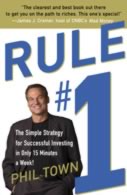An introduction to financial statements
Today's episode of "Saving and Investing" features three short videos, each of which is an introduction to a particular financial statement. Learning to read financial statements can help you evaluate the companies in which you would like to invest. (These statements are mandatory parts of corporate financial reports.)
First, Michael Fischer explains balance sheets:
https://www.youtube.com/watch?v=v_EpPu5tiXY
What is Leverage?
In today's episode of "Saving and Investing", Michael Fischer explains a concept I've heard mentioned a lot, but have never understood. The term "leverage" is used in many financial books and articles, often referring to real estate investments. The concept has always puzzled me, even when I looked it up. Michael's explanation is short and to the point. Leverage makes perfect sense now.
https://www.youtube.com/watch?v=GBsyA0JGFLA
A simple example of financial leverage: Say you have $10 that you want to invest in a stock. If you invest that $10 and it goes up 10%, you've made $1. However, if you're able to borrow an additional $90 to purchase that stock, you'd have $100 total to invest. If that stock goes up 10%, you've made $10. This is leverage: borrowing money to magnify returns. (Of course, losses are magnified as well.)
Book Review: Time is Money
One of the most puzzling things about money is knowing where to begin. You get out of college and suddenly find yourself in the real world, with a job, with rent, with student loans, and wonder how you're going to make ends meet, let alone save for retirement. Retirement seems so far away. It's easy to just forget about it.
![]() Ignoring retirement could be one of the biggest financial mistakes you'll ever make. Compound returns favor the young. Time is money. Invest now and your 40-year-old self will be grateful. But where do you start?
Ignoring retirement could be one of the biggest financial mistakes you'll ever make. Compound returns favor the young. Time is money. Invest now and your 40-year-old self will be grateful. But where do you start?
Frances Leonard's 1995 book, Time is Money, is an excellent introduction to retirement for people in their twenties and early thirties. Leonard preaches the important message: start now.
Prosper: Investing on YOUR Terms
Note: I've received many questions about Prosper, but I've never used it. Here's a post from Frykitty, the very very quiet second author at Get Rich Slowly. She recently set up a Prosper account and has written to share her experience.
Last December I discovered Prosper, a site that connects private lenders and borrowers, and manages the resulting loans. Because I'm not a fan of the stock market, this looked like a perfect opportunity to invest on my terms, to help individuals with faces and stories, rather than contribute to the bottom-line culture. I decided to start the new year by testing Prosper with a set amount of funds to see how it performed.
Borrowers sign up on Prosper, then post a request for a loan and the maximum amount they're willing to pay in interest. Lenders then bid to fund all or part of that loan, at an interest rate of their choosing. You win a bid by coming in at a lower interest rate than your competitors.
Are index funds the best investment?

For 35 years, Bay Area finance revolutionaries have been pushing a personal investing strategy that brokers despise and hope you ignore. [This is] the story of a rebellion that's slowly but surely putting money into the pockets of millions of Americans, winning powerful converts, and making money managers from California Street to Wall Street squirm.
So writes Mark Dowie in a recent issue of San Francisco magazine. Dowie describes how Google prepared for its IPO in 2004. Aware that hundreds of young employees would soon be millionaires, the company brought in a series of financial experts to teach them to make smart investment choices.
The beauty of penny stocks
William at A Financial Revolution has some words of advice on penny stocks.
The beauty of penny stocks is that they are one of the only investments for which one simple, blanket rule applies without any exceptions: There is never a good reason to buy a penny stock, ever.
Why not?
The billionaire next door: The wisdom of Warren Buffett
Warren Buffett is one of my heroes. He's the second-richest man in the world, yet he lives more frugally than I do. CNBC recently broadcast an interview with Buffett. Naturally, it's been posted to YouTube. Here's the show in its entirety (with notes and excerpts I made while watching). [Update March 7, 2018: The show is no longer available online]
As a kid, Buffett would go door-to-door selling chewing gum and Coke. He'd buy six bottles for a quarter, and then sell them for a nickel each. He bought his first stock at the age of eleven. He bought a 40-acre farm at the age of fourteen using money he had saved from a paper route.
Some of his fundamental tenets for investing are:
Intro to Mutual Funds: Index Funds
Before I delete the GRS forums, I'm moving the best posts here. Last month I shared Vintek's introduction to mutual funds. Here he explains index funds.
In my previous discussion of mutual funds, I mentioned index funds:
Along came index funds, and this was hailed as the ultimate in investing. You'd invest not in just a basket of stocks, but in the entire market. Since the manager wasn't required to do research and pick stocks (all he had to do was buy it all and hold it), his fee was reduced to a fraction of an actively managed fund's fees (about 0.2%). Yes, you could have years of losses (2000, 2001 and 2002 were the most recent), but studies show that the market always recovered, even if some of the companies in the index didn't. If you wanted put your investing on autopilot and be assured of a long-term (any 20 year period since the 1920s had an average gain of 10% per year) winner, this was the way to go.
Phil Town’s rule #1 investing
 Rule #1 by Phil Town is not a general personal finance book, and it's not a book for beginning investors — it turns a lot of conventional investment wisdom on its ear. The book explores a philosophy ascribed to Columbia University's Benjamin Graham (author of The Intelligent Investor), and popularized by Graham's student, Warren Buffet (perhaps the most successful investor of all time).
Rule #1 by Phil Town is not a general personal finance book, and it's not a book for beginning investors — it turns a lot of conventional investment wisdom on its ear. The book explores a philosophy ascribed to Columbia University's Benjamin Graham (author of The Intelligent Investor), and popularized by Graham's student, Warren Buffet (perhaps the most successful investor of all time).
What is The Rule? "There are only two rules of investing: Rule #1: Don't lose money [...] and Rule #2: Don't forget Rule #1." Town writes: "Most Americans are trapped in mutual funds that, at best, ride the waves of the market." He believes that his method can help investors break free from these cycles.
At its heart, Town's philosophy is simply "buy low, sell high". He's not pushing a get-rich-quick scheme (though at times, especially early in the book, that's exactly how it comes across). But he's certainly encouraging his readers to abandon traditional "get rich slowly (and surely)" techniques. Continue reading...